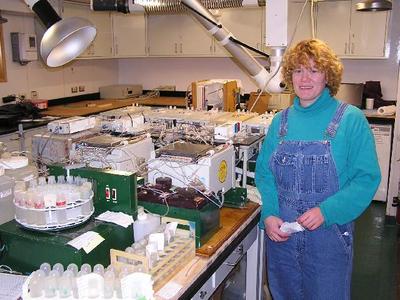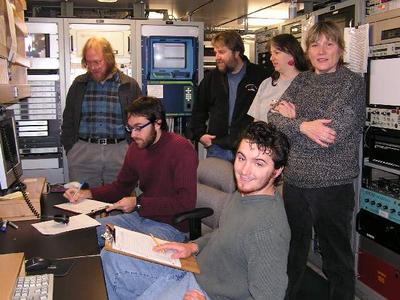6 August, 2003
Chief Scientist's Report #5
R/V Nathaniel B. Palmer SBI Survey Cruise
James H. Swift
6 August 2003, ca. 1:30 pm Alaska time - from R/V Nathaniel B. Palmer
on the outer Chukchi Shelf
We have now completed 218 stations in the SBI study area, including
during the past week much of our planned survey of the Chukchi shelf.
Our plans for the remaining 10 days of sampling include a survey of
the outer shelf incorporating a high-resolution section across Herald
Valley, repeats of two or three of the sections occupied earlier
during the cruise, and a final section east of previous SBI sections.
Although this promises to be as busy a time as any during the cruise,
all hands have the goal of completing that final section clearly in
sight.
>From the individual CTD casts that make up the 10-12 we do each day
>on the shelf, the larger spatial structure of the property
>distributions is not always apparent. And one might wonder what
>degree of lateral variability and vertical structure might be found
>over the shallow (ca. 50 meter deep) shelf. But we sometimes see
>three or more layers at a shelf station, and when the individual
>profiles are combined into the long sections which form the survey,
>meaningful patterns come clear. We can trace a Bering Strait
>component with an unusual nutrient signature, we have found a shelf
>region where the near-bottom waters are very high in nutrients, we
>have found transition zones where the chlorophyll maximum shifts
>significantly in the vertical, we may be identifying areas where the
>shelf waters break into the slope region, and Eric Johnson sees in
>the lowered ADCP data some consistent flow features over the shelf
>break and in the canyons.
Weather during the past week has been summer-typical gray, cold and
often foggy, with rain at times. The weather broke open long enough
as we neared the end of our first long shelf section, off Alaska,
that we were able to return Community Parcticipant Luther Leavitt,
Jr., home to Barrow. Later in the week a weather system passed with
winds in the 35-40+ knot range, but as with previous windy periods,
in the ice the high winds had little immediate effect on the ship
other than increasing its drift. The sea ice cover continues to be
broken by many broad leads, with the ice composed only of rotting
first year ice, and so making way has proved no problem for the
Palmer.
We continue to enjoy excellent support from the Raytheon Polar
Services technical group and from all hands in the Edison Chouest
Offshore group. We are favored with excellent winch operators, who
help make each cast the safe, smooth operation intended.
Despite foggy weather that continues to hamper aerial surveys, the
marine mammal team has succeeded in adding to its sample of marine
mammal observations. They have been conducting surveys from the
ship's ice tower as our cruise track has taken us across the
continental shelf. A brief break in the weather also allowed
collecting 340 nautical miles of marine mammal line transect data
from the helicopter. Their observations included relatively high
densities of bearded seals in an area where the benthic productivity
is presumably high, and they are eager to compare these results with
relevant findings from other SBI investigators.
Equipment and personnel are working well, the food is good and
plentiful, and the data are pouring in.
All is well.

Chlorophyll analyst Stephanie Moreland prepares another sample.

Nutrients analyst Susan Becker runs the auto-analyzer in the Hydrolab.

TEA parcticipant Jim Rogers looking for seals (and Ivory Gulls) in the Palmer's Ice Tower.

The Night Watch monitors a CTD cast, standing from left to right: LADCP Data Analyst Dr. Eric Johnson, Electronics Technician John Calderwood, Chlorophyll Analyst Stephanie Moreland, and Data Processor, Kristin Sanborn; and seated in front, Marine Technician Paul Ellis, and behind him, Doctoral candidate Leopoldo Llinas.

Marine Mammal Survey Team in the Palmer's Ice Tower, from right to left: Dr. Mike Cameron, Dr. John Bengston, and graduate student, Heather Smith.
Contact the TEA in the field at
.
If you cannot connect through your browser, copy the
TEA's e-mail address in the "To:" line of
your favorite e-mail package.
|
